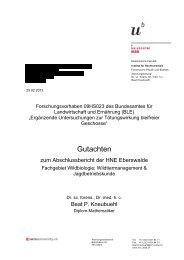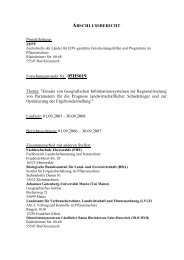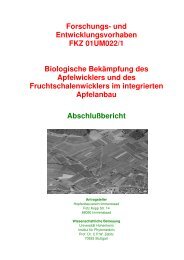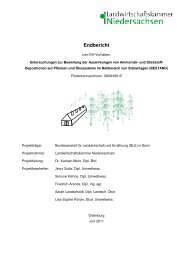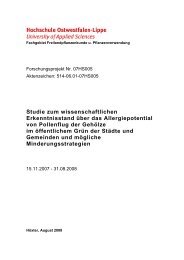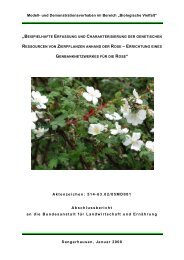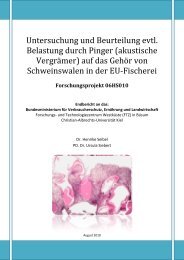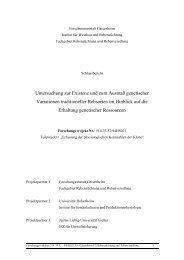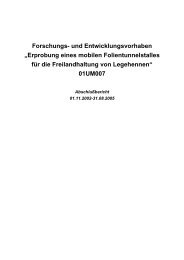Abschlussbericht Projekt: „Verminderung der ... - BLE
Abschlussbericht Projekt: „Verminderung der ... - BLE
Abschlussbericht Projekt: „Verminderung der ... - BLE
Sie wollen auch ein ePaper? Erhöhen Sie die Reichweite Ihrer Titel.
YUMPU macht aus Druck-PDFs automatisch weboptimierte ePaper, die Google liebt.
Discussion<br />
Distribution of tubers with different specific gravities within each cultivar. In general,<br />
the specific gravity of potato tubers is assumed to be special attributed to cultivars<br />
(Laboski and Kelling 2007). However, presented investigations indicated that the specific<br />
gravity of tubers ranged between 1.095 kg L -1 independent of given cultivars.<br />
This is due to the fact that growing and storage conditions might overrule some conditions<br />
of cultivar dependent specific gravity formations as mentioned by Laboski and Kelling<br />
(2007). Tubers harvested from the same field differed in their specific gravity up to 0.008<br />
to 0.010 units only. Investigated cultivars where grown in single hills in the same field and<br />
performed an individual set of specific gravities, whereby the sets of specific gravities of<br />
cultivars differed form each other about 0.010 units. The observed range of specific gravities<br />
about 0.039 units within a single cultivar and hill is quite possible and followed the<br />
hierarchy of tubers to accumulate dry matter and water as observed by Bussieres (1993),<br />
Kolbe and Stephan-Beckmann (1997) and Struik et al. (1991). This sink-strengh hierarchy<br />
is greatly affected by competitory relationships between plants and plant individual distributed<br />
stems and are partially open to influence as described by Struik et al. (1990) in<br />
detail.<br />
Blackspot index and tuber components attributed to specific gravity. The BSI of tubers<br />
of various specific gravities was not correlated with the concentrations of dry cell wall<br />
material, pectin or non-pectin components (celluloses, hemicelluloses). Both parameters<br />
affect cell wall thickness and cell wall firmness in potato tubers (Bush et al. 2001). Therefore<br />
present results indicated that neither cell wall thickness nor cell wall firmness was<br />
attributed to tuber blackspot bruise susceptibility. Other types of bruise like crushing, shatter<br />
and cracking lead to visible cell wall rupture (Baritelle and Hyde 2003) but blackspot<br />
bruise is invisible until the tuber is peeled because the tuber skin is not damaged or broken<br />
after impact (Wright et al. 2005). Nevertheless, blackspot bruise formation depends on a<br />
linkage between PPO and substrates normally stored in different cell compartments divided<br />
by cell membranes. Therefore, the consistence of the cell membranes characterise<br />
blackspot susceptibility of the tuber. Many reports assumed a decompartmentation of PPO<br />
and substrates, while the cell membranes were ruptured during impact (Story 2007; van<br />
Eck 2007; van Loon and van den Berg 2003/2004). In the present investigations structural<br />
damages, which lead to necrosis or cell death were not observed. Moreover, tubers were<br />
vital and turgid after harvest as well as after five and eight months of storage (Wulkow et<br />
al. in preparation) independent of their blackspot bruise susceptibility. Presented findings<br />
indicated an intact cell metabolism of potato tubers after impact and blackspot bruise formation.<br />
According to the presented results some authors studied the appearance of cell<br />
membrane using different microscope techniques and they detected no cell membrane rupture<br />
after impact (Barkhausen 1978; Edgell et al. 1998; Reeve 1968). We assume that the<br />
impact leading to blackspot bruise is a kind of mechanical stress, which might be focused<br />
on mechanosensitive channels as described by Larcher (1994) and Yahraus (1995) in de-<br />
204




